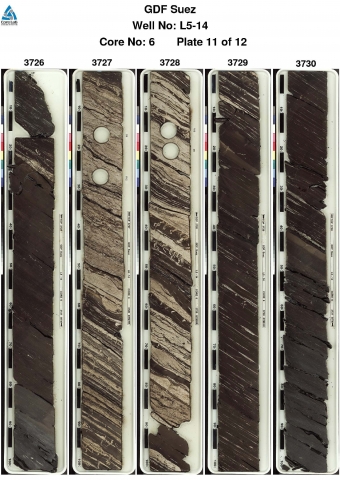Code
ATAL
Status
Formal (NAM & RGD 1980). Amended (Van Adrichem Boogaert & Kouwe 1994).
Lithological description
Sequence of dark-grey, occasionally calcareous, locally silty to sandy claystones containing occasional thin argillaceous limestone beds. At the base, a distinct argillaceous limestone interval is found. Pyrite, macrofossils (ammonites, belemnites, gastropods, etc., frequently pyritised), iron oolites and siderite nodules can be encountered.
Depositional setting
Relatively shallow to open-marine, neritic environment. With occasional but non-permanent water-column stratification phases.
Definition of lower boundary
The basal argillaceous limestone interval marks the transition from the brown claystones of the underlying Sleen Formation.
Definition of upper boundary
Placed at the base of the bituminous claystone interval of the Posidonia Shale Formation.
Thickness indication
Very variable as a consequence of erosion. If complete between 500 and 1000 m.
Geographical distribution
Regional correlation
UK: Ida, Offa and Penda Formations; GER: Lias Group; BEL: Aalburg Formation.
Age
Hettangian - earliest Toarcian.
Holostratotype
Well:
Depth (thickness) AH:
2228 - 2803 m (575 m)
Origin of name
Named after the municipality of Aalburg in ‘Het Land van Altena’ (northern part of the Dutch province of Noord-Brabant).
Previous name(s)
None.
Reviewed by (date)
Sander Houben (2017).
References
NAM & RGD 1980. Stratigraphic nomenclature of The Netherlands. Verhandelingen van het Koninklijk Nederlands Geologisch Mijnbouwkundig Genootschap 32, 77 p.
Van Adrichem Boogaert, H.A. & Kouwe, W.F.P. 1994. Stratigraphic nomenclature of The Netherlands; revision and update by RGD and NOGEPA, Section F, Lower and Middle Jurassic. Mededelingen Rijks Geologische Dienst, 50, 1-20.
Cite as
TNO-GDN ([YEAR]). Aalburg Formation. In: Stratigraphic Nomenclature of the Netherlands, TNO – Geological Survey of the Netherlands. Accessed on [DATE] from http://acc.dinoloket.nl/en/stratigraphic-nomenclature/aalburg-formation.
